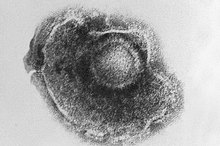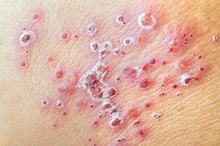How Long Does Shingles Pain Last?
Shingles
Shingles is caused by the herpes zoster virus, the same virus that is responsible for chicken pox infection. Even though a chicken pox infection will resolve, the herpes zoster virus remains in a person’s nervous system for the rest of their life. The virus usually hibernates in the spinal cord, and when a person’s immune system is weakened, the virus can be reactivated. According to the National Institutes of Health (NIH), individuals who have had chicken pox have a one in five chance of developing shingles as an adult 1.
- Shingles is caused by the herpes zoster virus, the same virus that is responsible for chicken pox infection.
- Even though a chicken pox infection will resolve, the herpes zoster virus remains in a person’s nervous system for the rest of their life.
Typical Disease Course
Shingles outbreaks run a similar course to a chicken pox infection. During the first two to three days, people may feel tired and feverish. These symptoms are followed by development of a localized area of skin irritation. A tingling, itching or painful burning sensation will develop, most commonly on the upper body. However, shingles can develop on the extremities and face as well. The hallmark indicator of shingles is unilateral symptoms (one side of the body is affected). This is because the virus follows a specific nerve path, or dermatome, beginning in the spine and following the dermatome to the surface of the skin.
The next phase of a shingles infection is a one-to-two-week period of blistering rash development. This rash is similar to chicken pox and can take seven to 14 days to scab over. Typically, another one to two weeks are needed for the lesions to completely heal.
A simple course of shingles can last anywhere from one month to several months. The severity and duration of the infection are dependent on the age and health of the affected person. According to the NIH, age and physical and emotional stress can weaken a person’s immune system, making them more susceptible to prolonged shingles outbreaks.
- Shingles outbreaks run a similar course to a chicken pox infection.
- This rash is similar to chicken pox and can take seven to 14 days to scab over.
Post-Herpetic Neuralgia
Complications of Cellulitis
Learn More
According to neurologist Dr. Hana Aubrechtova with the Austin Neurological Clinic, shingles can cause serious chronic complications 2. A condition called post-herpetic neuralgia can occur, resulting in protracted pain. People with this development report hypersensitivity to the skin in the affected area. Very light touch to the area can cause severe pain and burning. The simple contact of clothing on skin can become intolerable. These symptoms may never resolve.
Dr. Aubrechtova states that the virus may travel along different cranial nerves with the potential to cause permanent damage to those nerves 2. For example, if the trigeminal nerve is affected, the result could be severe shooting facial pain and numbness. rarely, the cornea could be affected by ulceration and subsequent visual impairment.
According to the Centers for Disease Control, two potentially life-threatening complications of shingles are pneumonia and encephalitis, or brain inflammation 3. Another serious complication of shingles outbreak is a development of secondary infection in the rash.
- According to neurologist Dr. Hana Aubrechtova with the Austin Neurological Clinic, shingles can cause serious chronic complications 2.
- Dr. Aubrechtova states that the virus may travel along different cranial nerves with the potential to cause permanent damage to those nerves 2.
Related Articles
References
- Centers for Disease Control and Prevention. Shingles (Herpes Zoster) Signs & Symptoms.
- Centers for Disease Control and Prevention. Shingles (Herpes Zoster) Signs & Symptoms.
- John AR, Canaday DH. Herpes Zoster in the Older Adult. Infect Dis Clin North Am. 2017;31(4):811-826. doi: 10.1016/j.idc.2017.07.016
- Yun H, Xie F, Baddley JW, Winthrop K, Saag KG, Curtis JR. Longterm Effectiveness of Herpes Zoster Vaccine among Patients with Autoimmune and Inflammatory Diseases. J Rheumatol. 2017;44(7):1083-1087. doi: 10.3899/jrheum.160685
- Cohen KR, Salbu RL, Frank J, Israel I. Presentation and Management of Herpes Zoster (Shingles) in the Geriatric Population. P T. 2013;38(4): 217-224, 227.
- Galetta KM, Gilden D. Zeroing in on zoster: A tale of many disorders produced by one virus. J Neurol Sci. 2015;358(1-2):38-45. doi: 10.1016/j.jns.2015.10.004
- Blank LJ, Polydefkis MJ, Moore RD, Gebo KA. Herpes zoster among persons living with HIV in the current antiretroviral therapy era. J Acquir Immune Defic Syndr. 2012;61(2):203-7. doi: 10.1097/QAI.0b013e318266cd3c
- Mallick-searle T, Snodgrass B, Brant JM. Postherpetic neuralgia: epidemiology, pathophysiology, and pain management pharmacology. J Multidiscip Healthc. 2016;9:447-454. doi: 10.2147/JMDH.S106340
- Johnson RW, Bouhassira D, Kassianos G, Leplège A, Schmader KE, Weinke T. The impact of herpes zoster and post-herpetic neuralgia on quality-of-life. BMC Med. 2010;8:37. doi: 10.1186/1741-7015-8-37
- Sampathkumar P, Drage LA, Martin DP. Herpes zoster (shingles) and postherpetic neuralgia. Mayo Clin Proc. 2009;84(3):274-80.
- Pereira LB. Impetigo - review. An Bras Dermatol. 2014;89(2):293-9. doi: 10.1590/abd1806-4841.20142283
- Gershon AA, Breuer J, Cohen JI, et al. Varicella zoster virus infection. Nat Rev Dis Primers. 2015;1:15016. doi: 10.1038/nrdp.2015.16
- Naveen KN, Pradeep AV, Kumar JS, Hegde SP, Pai VV, Athanikar SB. Herpes zoster affecting all three divisions of trigeminal nerve in an immunocompetent male: a rare presentation. Indian J Dermatol. 2014;59(4):423. doi: 10.4103/0019-5154.135548
- Opstelten W, Zaal MJ. Managing ophthalmic herpes zoster in primary care. BMJ. 2005;331(7509):147-51. doi: 10.1136/bmj.331.7509.147
- Jeon Y, Lee H. Ramsay Hunt syndrome. J Dent Anesth Pain Med. 2018;18(6):333-337. doi: 10.17245/jdapm.2018.18.6.333
- Kim SH, Choi SM, Kim BC, et al. Risk Factors for Aseptic Meningitis in Herpes Zoster Patients. Ann Dermatol. 2017;29(3):283-287. doi: 10.5021/ad.2017.29.3.283
- Saxena A, Khiangte B, Tiewsoh I, Jajoo UN. Herpes zoster encephalitis presenting as multiple cerebral hemorrhages - a rare presentation: a case report. J Med Case Rep. 2013;7:155. doi: 10.1186/1752-1947-7-155
- Teo HK, Chawla M, Kaushik M. A Rare Complication of Herpes Zoster: Segmental Zoster Paresis. Case Rep Med. 2016;2016:7827140. doi: 10.1155/2016/7827140
- American Academy of Dermatology. Cellulitis: Overview.
- American Academy of Ophthalmology. Herpes Zoster Ophthalmicus.
- Centers for Disease Control and Prevention. Shingles (Herpes Zoster): Clinical Overview. Feb 21, 2018.
- Mayo Clinic. Postherpetic Neuralgia. Sept 16, 2015.
Writer Bio
Patricia Nevins is a registered nurse with nearly 20 years of nursing experience. She obtained her Master of Science in nursing with a focus in education from the University of Phoenix. Nevins shares her passion for healthy living through her roles as educator, nursing consultant and writer.









